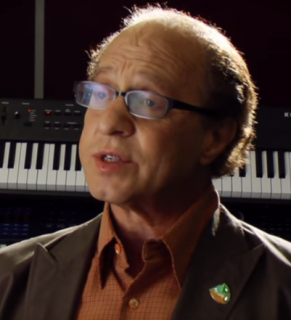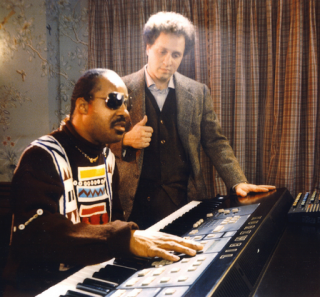 Inventor Ray Kurzweil will receive the 2015 Technical Grammy Award Sunday, Feb 8th, for his work in the field of music technology.
Inventor Ray Kurzweil will receive the 2015 Technical Grammy Award Sunday, Feb 8th, for his work in the field of music technology.
The Technical Grammy Award is a Special Merit Award presented by vote of the National Academy of Recording Arts & Sciences Trustees, for contributions of outstanding technical significance to the recording field.
Kurzweil is a best selling author, futurist, computer scientist and inventor. He is credited as a principal innovator of omni-font optical character recognition, text to speech synthesis and speech recognition technology.
He founded Kurzweil Music Systems in 1982 and in 1984 introduced the Kurzweil K250, a computer based instrument that could realistically create sounds of a grand piano and other orchestra instruments.
Kurzweil’s Music Synthesizers
Ray Kurzweil’s early 1980s successes included synthesizers he engineered with the creative input of musician Stevie Wonder.
“When I met Stevie Wonder in 1976, we gave him the first Kurzweil Reading Machine for the Blind,” notes Kurzweil. “It began what is now a thirty year friendship.”
Here’s Kurzweil’s account of how is relationship with Wonder led to the creation of the Kurzweil synthesizer:
 Stevie Wonder and I collaborated to create the first computerized musical instrument that could realistically recreate the piano and other orchestral instruments.
Stevie Wonder and I collaborated to create the first computerized musical instrument that could realistically recreate the piano and other orchestral instruments.
On one of my visits with Stevie Wonder at his Los Angeles recording studio in 1982, he lamented the state of affairs in the world of musical instruments.
On the one hand, there was the world of acoustic instruments, such as the piano, violin and guitar, which provided the rich complex sounds of choice for most musicians. While musically satisfying, these instruments suffered from a panoply of limitations.
Most musicians could play only one or two different instruments. Even if you could play more than one, you couldn’t play more than one at a time.
Most instruments only produce one note at a time. There were very limited means available to shape the sounds. On the other hand, there was the world of electronic instruments, in which these control limitations disappeared.
In the computerized world, you could record one line of music on a sequencer, play it back and record another sequence over it, building up a multi-instrumental composition line by line. You could edit wrong notes without replaying the entire sequence.
You could layer multiple sounds, modify their sonic characteristics, play songs in non-real time, and use a great variety of other techniques. There was only one problem.
The sounds you had to work with in the electronic world sounded very thin, rather like an organ, or an electronically processed organ.
Wouldn’t it be great, Stevie mused, if we could use the extraordinarily flexible computer control methods on the beautiful sounds of acoustic instruments? I thought about it and it sounded quite doable, so that meeting constituted the founding of Kurzweil Music Systems, and defined its raison d’être.
My conversations with Stevie Wonder over the years culminated in his challenge to build a bridge between the acoustic world and the computer world of music. We decided to work together and founded Kurzweil Music Systems.
With Stevie Wonder as our musical adviser, we set out to combine these two worlds of music. In June of 1983, we demonstrated an engineering prototype of the Kurzweil 250 and introduced it commercially in 1984. The K250 is considered to be the first electronic musical instrument to successfully emulate the complex sound response of a grand piano and virtually all other orchestral instruments.
Kurzweil sold Kurzweil Music Systems to a Korean company, Young Chang, the world’s largest piano manufacturer, in 1990. KMS lives on and their keyboards are now sold in 45 countries.

Good on you Ray!
Although I normally produce using various other boxes & software, my K is always the machine that I write with (with everything else turned off).
I’m right there with ya, Vince.
I have a K2500RS that I still use pretty regularly for quick sounds, and for it’s one-of-a-kind mapping features.
My K2661 is the center of my live rig.
The K2xxx series of instruments were truly ground-breaking and still have some powerful features not found in most high-end keyboards.
I was never interested in the PC3 series, as the ability to load samples is a central part of my workflow. And even though the PC3K added that option, it was kind of added in (no live mode, etc.).
Ray Kurzweil is an impressive, and odd character, capable of brilliance and eccentricity. He has a deep understanding of what technology can do. One wonders if his ideas about the future of tech will come to pass.
Kurzweil is the man, a true contemporary genius and pioneer.
Agree with all the K love. Wish he was still making instruments!
PC3LE6 is my most “professional” and expensive synth and VAST sound is amazing. But I would love Kurzweil to bring something really new some time soon.
I hope , AGAIN, in a new KURZWEIL K3000………..
I HAVE MY FIRST KURZWEIL K2000 VERSION 2 SYNTHESIZER?” AND IT SOUNDED GREAT, IT HAD A LOT OF HIGH END CLEAN SOUNDS TO FIND THE SYNTH LEAD SOUNDS THAT ALMOST SOUNDED A BIT LIKE GEORGE DUKE, ITS CALLED (DIG DAT DC LEAD) AND LONELY 5THs AND THESE BOARDS SHOW DO TALK TO YOU ON THE STUDIO,STAGE AND GIGS,NONSTOP PLAYING.
I love my K2000 RS, I love his writings on artificial intelligence and the Singularity (a little naive if you ask me, but has definitely reshaped the way I see mankind’s future, along with Alvin Toffler) and I love the man. Happy to see this honor bestowed on Mr. Kurzweil.
But really, why *hasn’t* someone remade VAST in software? It is just software. I would imagine Young Chang would have some copyright with an actual VAST clone but the basic concept could be extrapolated into something new. The algorithms are cool and perhaps proprietary but they’re really the most boring part of the synth—and the part that was built, I would imagine, due to processor constraints we don’t have anymore. The amazeballs is in all of the routing, layering and modulation possibilities, hindered for many by a 1991 interface.
Wish I was rich enough to sponsor a two-week ‘put your brains together’ get away:
Don Buchla
Ray Kurzweil
Tom Oberheim
Whomever is in charge at Livid
And that whizkid engineer at Korg that made the Volcas happen.